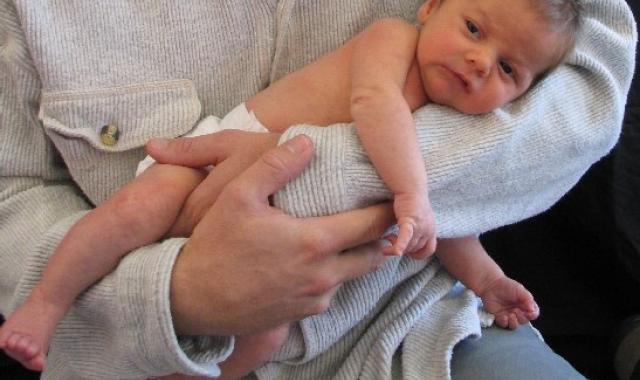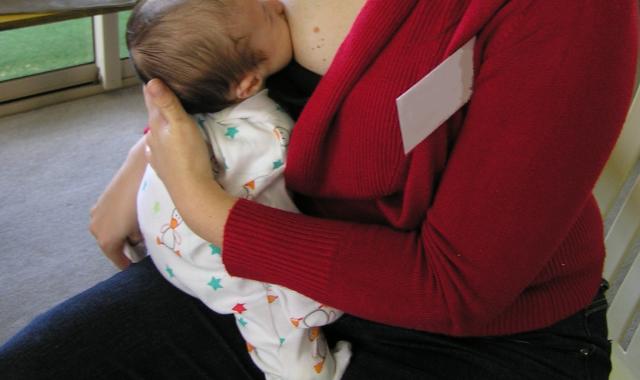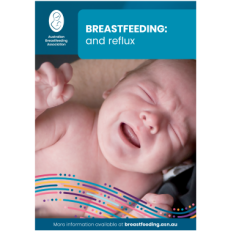Simple reflux and reflux disease – they’re not the same.

Reflux happens when stomach contents (such as breastmilk) move back up into a baby’s oesophagus (the tube that leads from the mouth to the stomach), and sometimes spill out of their mouth.
It is common for babies to bring up some milk, especially after a feed. This can be called spitting up, posseting, spilling or bringing milk up.
Reflux occurs in adults too, but we mostly don't notice it. Babies have a liquid diet and a short oesophagus, and spend more time lying down. These factors make reflux more noticeable.
Simple reflux
If your baby brings up milk but is otherwise happy and putting on weight well, they have what is called ‘simple reflux’. It doesn’t hurt your baby and it usually stops by itself as your baby grows.
Reflux disease
Gastroesophageal reflux disease (sometimes known as GORD) requires medical diagnosis and advice. With reflux disease, the acid in the stomach burns and causes damage to the oesophagus (the tube between the mouth and stomach). This is fairly rare. Only a small number of babies have vomiting which is linked with pain and crying.1
Babies with reflux disease usually need medical treatment. They often vomit a lot and have other symptoms such as:
refusal to feed
poor weight gains or weight loss
blood (bright or dark red) in their vomit
being fussy and upset during and/or after breastfeeds
coughing or wheezing during feeds 2,3
In some cases, babies may breathe in vomit that has come up from their stomach. This can be serious, especially if the baby is fed anything other than breastmilk.
If your baby fusses, cries a lot and arches their back, people might tell you that your baby has 'reflux'. However, if your baby doesn’t have the symptoms listed above, they are unlikely to have reflux disease.
Babies with reflux disease vomit a lot
It usually happens more in the first hour after feeding 4 and the vomit may contain blood from damage to the oesophagus. The blood is either fresh and bright red or old blood, which looks very dark, like coffee grounds. A baby with reflux disease may also show some or all of the following:
sleep problems
respiratory (breathing) symptoms
crying and irritability
feeding problems
poor weight gain
Could it be something else?
Before looking at medical treatments, check that there isn’t another reason for your baby’s behaviour.
One common cause of an unsettled baby is lactose overload. These babies gain weight well but have lots of ‘wind’ and usually don’t settle after feeds. This is often mistaken for reflux.
Research has shown a link between symptoms of reflux and an allergy or intolerance to cows’ milk protein.5,6 If you want to find out if your diet may be causing your baby’s reflux, first see your doctor to rule out any other causes of symptoms. You could then see an accredited dietitian who has a special interest in this area.
What can help?
If your baby has either type of reflux, there are some things you can do to help relieve some symptoms.
How to hold your baby
It often helps to feed your baby in a more upright position. You may need to try out different positions:
Sit your baby facing your breast, their legs on either side of your leg. Or cuddle them against the side of a sofa, facing your breast.
Instead of cradling your baby around your body, you can cradle baby down your body. To do this, you could feed twin-style or you could try feeding standing up.
Lie back so that your baby lies on top of your body.
After a feed, keep your baby upright and still. You may find putting them on your shoulder keeps them happier.

How often to feed
Some babies do better with smaller, more frequent feeds. This causes less pressure on the sphincter muscle between the oesophagus and the stomach. Your baby may not want both breasts at each feed or may do better if you offer only one side, but more often.
However, reflux episodes are worse in the first hour or so after feeds so your baby may prefer a larger feed less often. These babies may feed from both breasts at each feed and go longer between feeds. You may like to try a few of these to see what works best.
For more practical tips on coping with your baby’s reflux, see Bringing up milk (Posseting)
Should I keep breastfeeding?
People may suggest you change to formula. You might even wonder if giving your baby formula instead of breastmilk could be better for them. However, breastmilk is the normal food for all babies and is even more important for a baby with symptoms of reflux.
It’s easy to digest and contains everything they need for normal development.
If your baby breathes in their vomit, breastmilk is less harmful than formula.
Breastmilk has immune factors that help to heal sore or damaged areas in your baby’s gut. Formulas that claim to help with reflux lack these factors. They only differ from standard formula because they have thickener added.
Reflux is about as common in formula-fed babies as in breastfed babies. However, reflux episodes in formula-fed babies tend to happen more often and last longer.7,8
The smell of the vomit and poos of babies fed formula is much stronger than those of breastfed babies.
Formula is harder for a baby to digest. It cannot protect your baby from infection.
Support and information
Although babies usually ‘grow out’ of reflux, it can be a very difficult and tiring time for parents.
ABA's booklet Breastfeeding: and reflux combines the experiences of many families with the latest research into reflux. It includes practical suggestions for:
helping your baby with different holds and feeding positions
ways to improve sleep
gentle ideas for playtime
how to change your baby’s nappy without causing reflux.
The booklet has a section on strategies that have helped parents cope with reflux and includes parents' own stories.
ABA breastfeeding counsellors on the National Breastfeeding Helpline can discuss ideas to help you manage the reflux while breastfeeding your baby.
Further information about reflux can be found on the Raising Children Network webpage on Gastro-oesophageal reflux & GORD: babies.
Your health care provider may also be able to recommend local services that can provide you with support during this challenging time.
The information on this website does not replace advice from your health care provider.
© Australian Breastfeeding Association April 2022
- Davies, I., Birman-Roy, S., & Murphy, M. S. on behalf of the Guideline Development Group. (2015). Gastro-oesophageal reflux disease in children: NICE guidance. British Medical Journal, 350, 7703.
- Arguin, A.L. & Swartz, M.K. (2004). Gastroesophageal reflux in infants: A primary care perspective. Pediatric Nursing, 30(1): 45-71.
- The Royal Children’s Hospital Melbourne. (2019). Clinical practice guideline: Gastrooesophageal reflux disease in infants. https://www.rch.org.au/clinicalguide/guideline_index/Gastrooesophageal_…
- Rosen, R., Vandenplas, Y., Singendonk, M., Cabana, M., DiLorenzo, C., Gottrand, F.,... Tabbers, M. (2018). Pediatric gastroesophageal reflux clinical practice guidelines: Joint recommendations of the North American Society for Pediatric Gastroenterology, Hepatology, and Nutrition and the European Society for Pediatric Gastroenterology, Hepatology, and Nutrition. Journal of Pediatric Gastroenterology and Nutrition, 66(3), 516–554.
- Iacono, G., Carroccio, A., Cavataio, F., Montalto, G., Kazmierska, I., Lorello, D., … Notarbartolo, A. (1996). Gastroesophageal reflux and cow’s milk allergy in infants: A prospective study. Journal of Allergy and Clinical Immunology, 97(3), 822–827.
- Hill, D. J., Heine, R. G., Cameron, D. J., Catto-Smith, A. G., Chow, C. W., Francis, D. E., & Hosking, C. S. (2000). Role of food protein intolerance in infants with persistent distress attributed to reflux esophagitis. Journal of Pediatrics, 136(5), 641–647.
- Hegar B, Dewanti NR, Kadim M, Alatas S, Firmansyah A, Vandenplas Y 2009, Natural evolution of regurgitation in healthy infants. Acta Paediatrica, 98(7):1189-1193
- Parilla Rodriguez AM, Davila Torres RR, Gonzalez Mendez ME, Gorrin Peralta JJ 2002, Knowledge about breastfeeding in mothers of infants with gastroesophageal reflux. Puerto Rico Health Sciences Journal, 21(1):25-29.
Read more about managing reflux in your baby
Evidence-led info and practical tips from our Special Situation Information Series
Breastfeeding: and reflux




